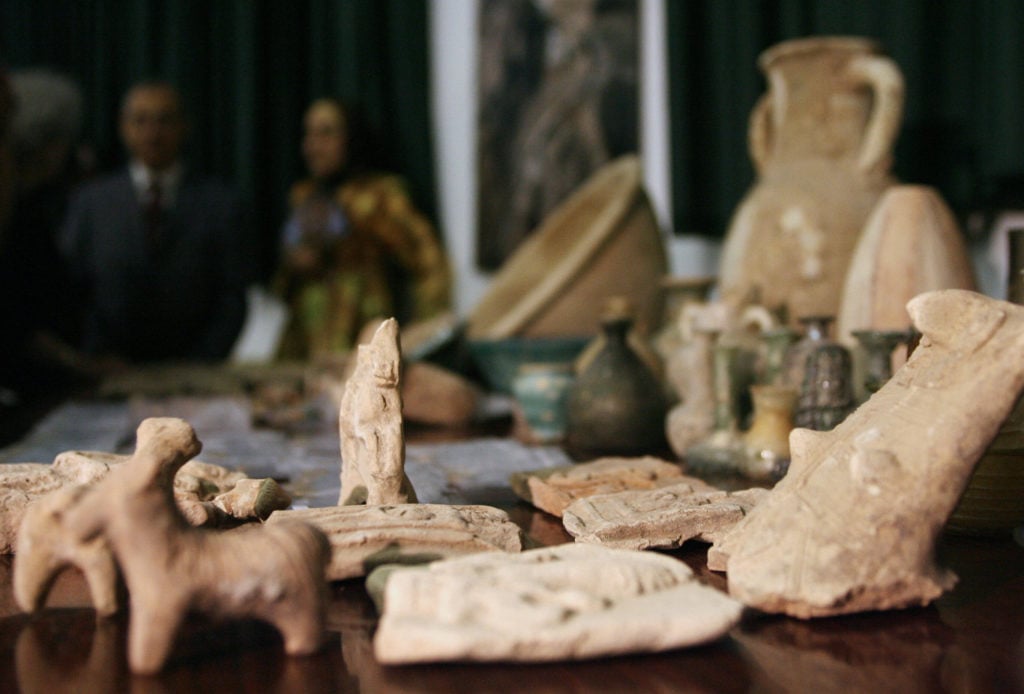Law & Politics
The Vast Majority of Antiquities Sold Online Are Probably Looted or Fake, a New Report Says
Illicit antiquities are now available on Snapchat.

Illicit antiquities are now available on Snapchat.

Julia Halperin

Planning to buy an ancient coin on eBay? Perhaps it would be wise to reconsider. Up to 80 percent of the antiquities for sale online are likely looted or fake, according to new research.
The Wall Street Journal has conducted a thorough investigation into the surge in illicit antiquities bought and sold online. Neil Brodie, a senior research fellow in Endangered Archaeology at the University of Oxford, estimates that 80 percent of the 100,000 antiquities available online at any given moment have no recorded provenance—which means they are probably looted or fake. These objects have a combined total asking price of more than $10 million, he says.
The explosion of fake and looted antiquities is the result of two combustible factors. First, ISIS has conducted unprecedented looting across the Middle East in recent years, bringing a wave of illicit objects into the marketplace. Second, novice collectors now have unprecedented access to un-vetted material thanks to the rapid growth of outlets like Facebook, WhatsApp, eBay, and Amazon.
“Social media democratized the art market, but it also democratized who can be victimized by the art market,” Colette Loll, the founder of the firm Art Fraud Insights, tells artnet News.
The WSJ spoke to an amateur collector from Worcestershire, England, who said he was offered a stone pharaoh’s head for $29,000 by a man from Yemen over Facebook messenger. Stephanie Mulder, a researcher at the University of Texas at Austin, told the newspaper that she, too, received an unsolicited Facebook message with pictures of gold coins and an ancient tomb. (She suspects she was targeted because she is a member of antiquities groups on Facebook.)
Ironically, dealers of fake or stolen art seem to have adapted to the digital revolution more quickly than many legitimate art galleries. Some possibly illicit works have even popped up on Snapchat, Loll tells artnet News. “It disappears, so you can hide the evidence,” she notes.
So far, the flood shows no signs of slowing down. The potent combination of new potential buyers, enterprising sellers, and an unregulated marketplace makes it “financially viable to trade in low-value and potentially high-volume material,” Brodie writes in a policy brief published by the Antiquities Coalition last month. As a result, sites that criminals might previously have considered unworthy of their time and effort “can now be viewed in a more lucrative light.”
While the European Commission and US officials have been monitoring the problem, a solution has largely eluded law enforcement, which is overwhelmed by the prospect of pursuing every suspicious listing. (eBay alone sells five collectibles per second, according to Brodie’s paper.) Loll likens the pursuit of stolen objects to a game of Whac-A-Mole: As soon eBay removes a listing, it might pop up on Amazon.
Nevertheless, experts say the situation is not utterly hopeless. Brodie suggests websites like eBay set an example by posting warnings more prominently and uniformly across the site. (A spokesperson for eBay did not return artnet News’s request for comment, but the Wall Street Journal notes that the website, like most others, has explicit policies prohibiting the sale of stolen objects. It has also reportedly agreed to give up the names and contacts of suspicious sellers to customs officials in countries where it operates.)
For her part, Loll believes a lasting solution is more likely to come from the demand side. “It’s going to be up to auction houses and dealers to come together and educate consumers,” she says. She notes that the popularization of the label “blood diamond” did much to encourage conscientious consumption of precious stones, and believes the same kind of reform is possible in the art industry.
But in order for that to happen, buyers must want to change their own behavior. “In my experience with art fraud in general, it’s not Joe Nobody who gets taken the most,” Loll says. “It’s someone with enough knowledge to be really interested in getting a unique find at a good price.”